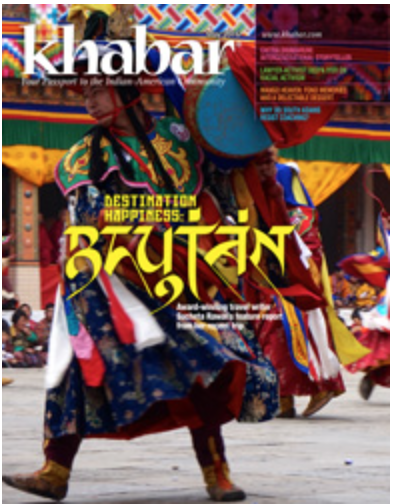Cover Story for Khabar Magazine. May 2016.
Our Druk Air plane makes a slow descent into Paro, maneuvering the aircraft through the deep valleys between tall dry mountains as high as 18,000 feet. Passengers hold their breath as we descend upon the only runway of the country’s sole international airport. I’m a bit on edge—and why not? Until 2009, only nine pilots in the world were certified to land at this challenging airport. Once on ground, my attention is drawn to the airport’s traditional architecture composed of wooden frames and small arched windows, resembling Swiss chalets. Swastikas and phallic paintings adorn some of the homes. Prayer flags flutter on hillsides. I have arrived in the Buddhist nation of Bhutan.
Bhutan is a small Kingdom about half the size of the state of Indiana, located between China, Nepal, and India. It is mostly known for its picturesque mountains and valleys, ancient monasteries, architecturally distinctive fortresses, and peaceful surroundings. While Bhutan was closed off to tourists for many decades, it has recently emerged as a travel destination, attracting visitors from all over the world.
Happiness is serious business
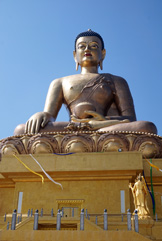
In the Western world, Bhutan has staked its claim to fame as the “Happy Nation.” That’s not just a smart tagline to attract tourists—happiness is serious business in Bhutan, where the government emphasizes measuring Gross National Happiness (GNH), rather than GDP, to ensure that its citizens are well provided for. Administrative and social policies are based on results of GNH, leading to free education across rural areas, access to healthcare, freedom of political speech, and so forth (reality check—this doesn’t necessarily mean that it is the happiest country in the world. In 2016, the World Happiness Report published by the United Nations ranked Bhutan as the 84th happiest country.).
Paro—land of legend
In winter, there are not many visitors in Paro, which resembles a small hill station in northern India. Paro’s foremost attraction is Taktsang Palphug Monastery or Paro Taktsang (also known as Tiger’s Nest). This 17th century Buddhist sacred site and temple complex is wedged into a tall, forbidding cliffside, and the thought that immediately comes to mind is, “What amazing engineering skills must those ancients have possessed?” Taktsang Palphug is the iconic backdrop of all marketing materials that describe Bhutan. Built in 1692, it is said to be the site where the legendary founder of Tibetan Buddhism, Guru Padmasambhava (aka Guru Rinpoche) flew to on the back of a tigress in the 8th century and meditated for three years, three months, three weeks, and three hours. Guru Rinpoche is revered as the country’s guardian saint who ushered Buddhism into this Land of the Thunder Dragon.
A round trip to the Tiger’s Nest Monastery takes about 4-6 hours of hiking through steep paths. Walking sticks, mules, and guides are available, though I decide to make the climb on my own. The true mark of a pilgrimage is allowing oneself to endure the struggle. Along the way, there are a couple of tea stalls where I stop to relax and enjoy amazing views of the valley full of blue pines and rhododendrons. Once I reach the monastery, it is cold and quiet. I envision centuries of introspection taking place in the prayer rooms through which I wander barefoot.
Dzongs and ancient storytelling
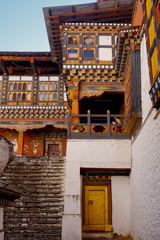
Back in the city of Paro, I stroll through the main street dotted with a few dozen souvenir shops, cafes, and restaurants. There are prayer wheels, Buddha statues, wood masks, beaded jewelry, and wool shawls, among other things. Most of the souvenirs are made in Nepal or India. The intricately designed Thangka paintings pique my interest. These are handmade Tibetan Buddhist scroll paintings on cotton and silk with applique work that depicts elaborate scenes from the life of the Buddha and various deities. Traditionally, these are used for meditations and religious festivals, and can cost up to a thousand dollars.
Along the river Paro Chhu stands the majestic Paro Rinpung Dzong, a fortress with fourteen shrines and chapels. While the word dzongloosely translates as ‘fortress,’ the structure has evolved into much more than that. Originally, the buildings served as monasteries; from the 17th century, they began to be constructed at remote, yet strategically advantageous points such as mountain spurs from which attacking invaders could be driven away. Thus dzongs became centers both of government as well as monastic living. Over time, national treasures were stored within their premises, as well as written records and weaponry. In famine periods, they functioned as centralized granaries. In modern times, dzongs across Bhutan house district administration offices, and monasteries and serve as centers for staging yearly cultural festivals.
One must follow certain rules when entering the dzongs, designated as formal areas, explains my Bhutanese guide, aptly named Karma. As a government official, he has to wear the national dress for men, called gho, which includes a knee length robe tied with a cloth belt, and a white scarf over his left shoulder. Being a tourist, I can pass in my jeans and sweater, but I cannot help cast admiring glances at Bhutanese women around me, dressed in beautiful kiras, traditional form-fitting, long skirts with silky short jackets and silver brooches.
As we make our way into the dzong, we see both sides of the walls covered by paintings. Each one depicts a story that conveys Buddhist philosophy and teachings. A riveting sight is the floor to ceiling depiction of the Wheel of Life or bhavacakra, a representation of the cyclic existence of living beings resulting from their karma—a central tenet of Buddhism.
Another image that catches my attention is that of an elephant, a monkey, a peacock, and a rabbit standing on each other’s back. Karma explains to me that this is a famous fable of the four friends. The animals used their friendship and cooperation to gather fruit from a tree. During the rest of my visit, I see this image at several shops and hotels.
On a hill above the dzong is a watch-tower, home to the National Museum of Bhutan. Here you can see national costumes, artillery, and Thangka paintings, as well as learn about the local wildlife. According to Bhutanese laws, 60% of the country should be preserved as forests, in order to balance the ecosystem. For a small country, there is plenty of wildlife including snow leopards, Bengal tigers, musk deer, and takin (or goat antelope).
Thimphu—the seat of the kingdom
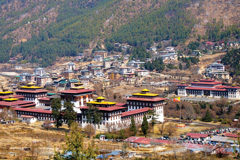 An hour’s drive takes me to Thimphu, the largest city and the capital of Bhutan. Of the country’s 750,000 residents, 100,000 live here. Urban life begins to emerge as I pass by commercial buildings, apartment blocks, colleges, and the national hospital. Streets bustle with locals and tourists as they go about their daily business passing by landmarks such as the Clock Tower Square and the National Post Office. The most notable luxury hotels in Thimpu include Taj Tashi, Le Meridien, and Indian chains, though there are also plenty of midrange options.
An hour’s drive takes me to Thimphu, the largest city and the capital of Bhutan. Of the country’s 750,000 residents, 100,000 live here. Urban life begins to emerge as I pass by commercial buildings, apartment blocks, colleges, and the national hospital. Streets bustle with locals and tourists as they go about their daily business passing by landmarks such as the Clock Tower Square and the National Post Office. The most notable luxury hotels in Thimpu include Taj Tashi, Le Meridien, and Indian chains, though there are also plenty of midrange options.
The most prominent landmark in Thimphu is the Tashichho Dzong, the largest dzong and the
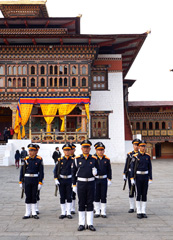 current administrative capital. Its whitewashed buildings laden with brick red roofs and golden spires against the lush green valleys make for stunning visuals. Visitors are allowed to tour the premises after office hours and can even see the throne room and the flag lowering ceremony.
current administrative capital. Its whitewashed buildings laden with brick red roofs and golden spires against the lush green valleys make for stunning visuals. Visitors are allowed to tour the premises after office hours and can even see the throne room and the flag lowering ceremony.
A recent addition to Thimpu’s attractions is the Buddha Dordenma Statue. It is one of the largest Buddha statues in the world, at a height of 51.5 meters. A winding road leads me to the top of the hill in Kuensel Phordrang nature park, arriving at the feet of the giant bronze Buddha statue. I am dwarfed by its majestic presence. 360-degree views of the city and its surroundings are visible from up here. The Dechencholing Palace, the official residence of the king, can be seen at the northern end of the Thimphu Valley. I climb a few stairs and make my way inside the statue. In the meditation hall, hundreds of monks dressed in saffron colored robes chant in unison, reciting in chhokey, the language of the ancient sacred texts, surrounded by another 125,000 smaller Buddha statues. Their sounds echo in the belly of the giant Buddha.
Punakha—heavenly valleys
My next destination is northeast to Punakha, the former capital of Bhutan. I cross roughly 45 miles in 3 hours, driving through bumpy dirt roads among some of the world’s tallest mountains. Located in the picturesque Punakha–Wangdue valley, Punakha is surrounded by rice terraces, fruit orchards, and two rivers that eventually meet the Brahmaputra River in India. ‘Development’ as we know it hasn’t transformed the town, and visitors come here to awaken to the morning mist, listen to the soft melody of birds chirping, breathe the fresh air blowing from the glacier mountains, and walk amidst the blooming spring flowers….heaven!
There is, of course, the inevitable dzong to visit. Punakha Dzong, also known as Palace of Great Happiness, is perhaps the most beautiful architectural building in the country, constructed in 1638. It also has a lot of historical importance as it was where the first King of Bhutan was crowned in 1907, and where the current king was married in 2011. Patrons must walk over a covered wooden cantilever bridge and feed the fish in the river for good luck, before making their way into the dzong. Inside, a long set of staircases lead me to the two-level courtyard center with a Bodhi tree, which is where all the main religious and communal activities take place. There are a few more courtyards that house the residences of the monks.
Festival of blessings
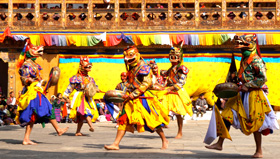
Every year, districts across Bhutan hold their own festival known as Tsechu, in order to celebrate
Bhutanese cultural heritage as well as remind people of Buddhist teachings. I attended the Punakha festival for three days in February. The entire village gathers in the courtyard of the Punakha Dzong, dressed in their finest attire, seated under the shade of the Bodhi tree. Dancers wearing masks of religious significance practice for months to portray the teachings of Guru
Padmasambhava. Folk dancers sing and dance traditional Bhutanese songs, while jokers chime in to entertain the crowds. Male monks dressed in colorful long skirts sway to the sounds of rhythmic drum beats. During the last dance of the Punakha Drubchen festival, the monks reenact scenes
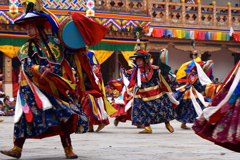 from the 17th century battle against the Tibetan army. It is believed that watching the dances blesses the audience and transmits principles of Tantric Buddhism.
from the 17th century battle against the Tibetan army. It is believed that watching the dances blesses the audience and transmits principles of Tantric Buddhism.
A week is sufficient to cover western Bhutan, which includes the cities of Paro, Thimphu, and Punakha. On a longer visit, there is much more to see in terms of architecture, history, and nature. In Central Bhutan, visit Bum-thang Valley and Gangtey to experience the origin of Buddhism and the country’s royal history. Eastern Bhutan may require another week to enjoy the natural beauty of agricultural lands and rainforests and explore the work of local artisans in Mongar, Trashigang, and Trashiyangtse.
Cuisine—simple n’ spicy
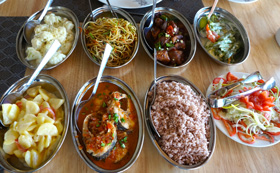 Rice and chilies are Bhutan’s staple crops. Bhutanese dishes bear strong culinary influences of neighboring China, India, and Nepal. Although there is a no kill policy, which means no animals in Bhutan can be slaughtered, meat is imported, and chicken, yak, beef, pork, and lamb are important components of Bhutanese diet. Vegetarians can enjoy red rice, lentils, and leafy and root vegetables, stir fried and stewed. Some of the traditional dishes include ema dashi(grilled green chilies with melted cheese) that is also used as a condiment to practically all dishes, thukpa (spicy noodle soup), momo (steamed dumplings stuffed with cheese or meat), phaksha paa (dried pork cooked with chili peppers and vegetables) and butter tea. Most restaurants also serve North Indian and Indo-Chinese dishes that are familiar to visitors from the Indian subcontinent.
Rice and chilies are Bhutan’s staple crops. Bhutanese dishes bear strong culinary influences of neighboring China, India, and Nepal. Although there is a no kill policy, which means no animals in Bhutan can be slaughtered, meat is imported, and chicken, yak, beef, pork, and lamb are important components of Bhutanese diet. Vegetarians can enjoy red rice, lentils, and leafy and root vegetables, stir fried and stewed. Some of the traditional dishes include ema dashi(grilled green chilies with melted cheese) that is also used as a condiment to practically all dishes, thukpa (spicy noodle soup), momo (steamed dumplings stuffed with cheese or meat), phaksha paa (dried pork cooked with chili peppers and vegetables) and butter tea. Most restaurants also serve North Indian and Indo-Chinese dishes that are familiar to visitors from the Indian subcontinent.
Pay up for happiness
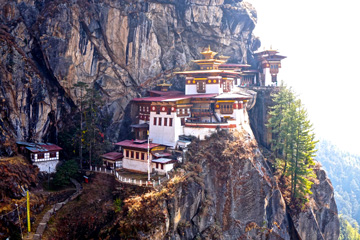 A trip to Bhutan doesn’t come cheap as the government discourages mass tourism in order to preserve the country’s fragile mountain ecology and cultural ethos. To this end, Bhutan limits the number of visitors per year and maintains a “High Value, Low Impact” tourism policy by charging a minimum $250 per person per day in royalty fees. Though this charge is set off against visa fees, accommodation (in basic 3-star hotels), 3 meals daily, guide, car, and sightseeing, Bhutan is not what your average tourist would call a value destination.
A trip to Bhutan doesn’t come cheap as the government discourages mass tourism in order to preserve the country’s fragile mountain ecology and cultural ethos. To this end, Bhutan limits the number of visitors per year and maintains a “High Value, Low Impact” tourism policy by charging a minimum $250 per person per day in royalty fees. Though this charge is set off against visa fees, accommodation (in basic 3-star hotels), 3 meals daily, guide, car, and sightseeing, Bhutan is not what your average tourist would call a value destination.
Upgrades in 5-star hotels will set you back by an additional $400+ per night above the royalty. Taxes on hotels, restaurants, and purchases amount to another 20%. Indian, Bangladeshi, and Maldivian passport holders have an advantage when traveling to Bhutan, as they are exempt from these requirements, making Bhutan a somewhat more affordabledestination for them. For the rest of the world, the “Happiness Destination” comes at a price, which is well worth it.
~ Appeared in Khabar Magazine in May 2016.
